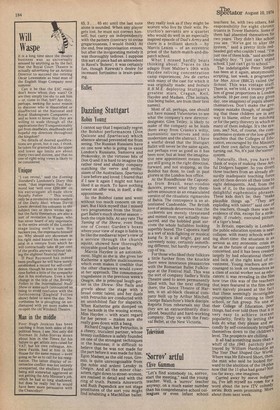Dazzling Stuttgart
Robin Young I cannot say that I especially regret the Bolshoi performances (Don Quixote and Spartacus) which absence abroad prevented me from seeing. The Russian Russians have no one now who is going to excel London's Russians, Samsova and Prokovsky, in the virtuoso bits of Don Q and it is hard to imagine the rather tired and shabby company matching the verve and enthusiasm of the Australians. Spartacus I saw before and loved: I feared that if I saw it again I might not have liked it as much. To have nothing newer on offer was, in itself, a disappointment.
So the Bolshoi came and went without too much concern on my part. But I kick myself that I missed two programmes from the Stuttgart Ballet's much shorter season — both the triple bills. At any rate The Taming of the Shrew, even from one of Covent Garden's boxes where your view of stage is liable to be like the mediaeval leper's view of a service through the church squint, showed how thoroughly enjoyable good ballet can be.
Marcia Haydee is an astonishment. Slight as she is. she gives her Katherine a spitfire maliciousness which even makes it credible that the other characters would cower at her approach. The consummate tragedienne in the previous week's Onegin, she is principal laugh-getter in the Shrew. She flails and growls about the stage with a broad comic talent, and her duels with Petruchio are conducted with an uninhibited flair for slapstick. When Katherine gets dumped on her backside in the wooing scenes, Miss Haydee — with scant regard for her person — makes sure she really goes down with a bang. Richard Cragun, her Petruchio, is a cheery, truculent partner, whose breezy confidence is safely founded on one of the strongest techniques in the business; it is difficult to believe that he was not made for the part before it was made for him. Egon Madsen as the old roue, Gremio, is quite unrecognisable from the noble and ardent Lensky in Onegin. And all the minor characters, right down to street-women, are realised in detail and with the ring of truth. Pamela Ainsworth and Ruth Papendick are not stage prostitutes of the sort you might find inhabiting a MacMillan ballet:
they really look as if they might be women who live by their wits. Pe truchio's servants are a quartet
who would do well in an especially inspired episode of Dad's Army and
there is a brilliant sketch — by Marcis Lesins — of an eccentric priest of the hatch-match-and-dispatch school.
What I missed hardly bears thinking about; Traces to the
adagio from Mahler's 10th with
Haydee reliving concentration camp experiences; Jeu de cartes
with many of the cast for which it
was originally made; and Initials R.B.M.E. deploying Stuttgart's
greatest stars, Cragun, Keil, Haydee and Madsen. (The initials, this being ballet, are from their first names).
Most of all, perhaps, one should not have missed Voluntaries to see what the company's new directordesignate, Glen Tetley, is likely to make of the company as he leads them away from Cranko's witty, humanistic narratives and into modernism and the abstract. I have a wistful dread that the Stuttgart Ballet will never be the same again, nor perhaps ever as good as it has been now; but at least the imaginative new appointment means they are still going in the right direction, forward, and not stopping, as the Bolshoi has done, to cash in past glories at the London box office.
At the Roundhouse the Capoeiras from Brazil, near-voodoo dancers, present what they themselves announce as an emasculated version of the ritualistic rigmaroles of Bahia. The centrepiece is an attentuated Candomble. The British love of animals determines that the cockerels are merely threatened and mimed over, not actually massacred, and the hobbled goat survives the whole hullabloo looking superbly bored. The Capoeira itself is a sort of kick-fighting or musical kung fu. It is all bright, gay and extremely noisy, certainly something different, but hardly everyone's cup of tea.
For those who liked their folklore a little further from the knuckle there were innocuous pleasantries with the Romanian Ballet Folklorique at the Festival Hall. This was the sort of company Sadler's Wells Theatre used to seem permanently filled with, but the next offering there, the Dance Theatre of Harlem, is an all-black classical company built up by Arthur Mitchell, George Balanchine's black disciple. Reports from rehearsals say that they are an extraordinarily disciplined, beautiful and hard-working company. They vie with the Festival Ballet, at the New Victoria.
































 Previous page
Previous page